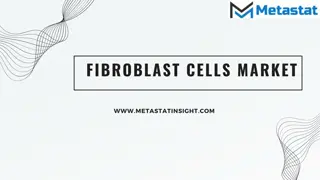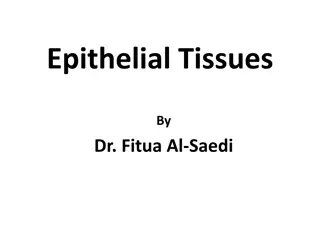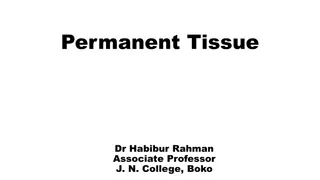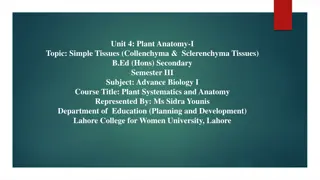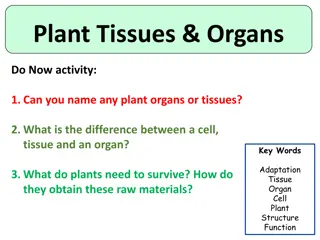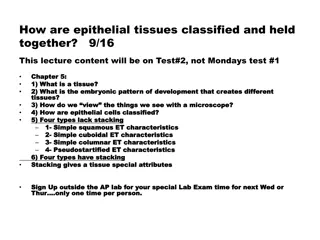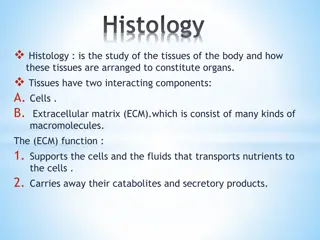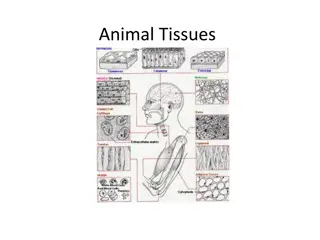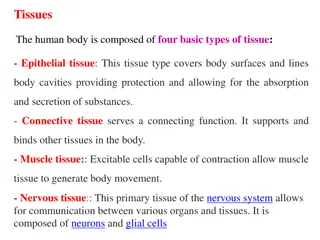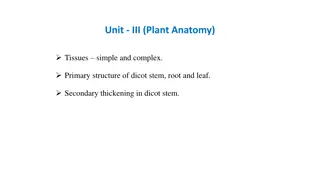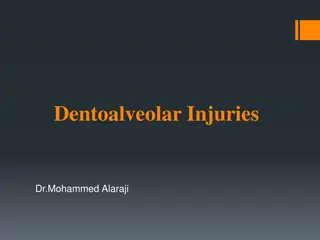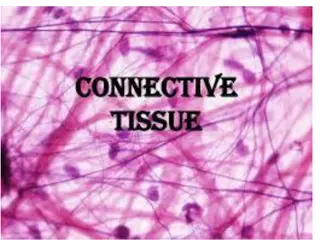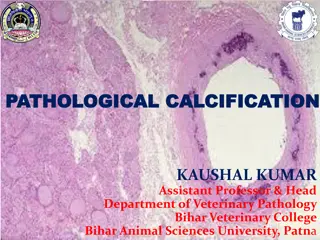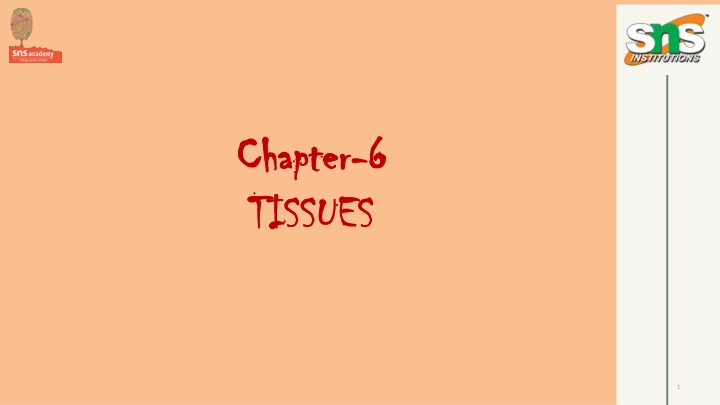
Understanding Plant and Animal Tissues: A Comparative Overview
Explore the differences between plant and animal tissues, including their structural characteristics, energy requirements, growth patterns, and specialization. Discover the roles of various tissues in supporting the functions of plants and animals.
Download Presentation

Please find below an Image/Link to download the presentation.
The content on the website is provided AS IS for your information and personal use only. It may not be sold, licensed, or shared on other websites without obtaining consent from the author. If you encounter any issues during the download, it is possible that the publisher has removed the file from their server.
You are allowed to download the files provided on this website for personal or commercial use, subject to the condition that they are used lawfully. All files are the property of their respective owners.
The content on the website is provided AS IS for your information and personal use only. It may not be sold, licensed, or shared on other websites without obtaining consent from the author.
E N D
Presentation Transcript
Chapter Chapter- -6 6 TISSUES TISSUES 1
Tissue: A group of cells that are similar in structure and work together to perform a particular function. Examples:- In plants vascular tissue Xylem and phloem Conduct food and water are example of tissue. In animals Muscles contracts and relax to cause movements are examples of tissue. 2/10
Difference between plant and animal tissues Plant Tissues Animal Tissues Plants do not move. Plants required less energy Animals moves from one place to another . Animals required more energy than plants. Most of the tissue provide them support and structural strength. Their tissues are the ones that can support movement. Most of tissues are dead in plants as they can provide mechanical strength easily and required less maintaince Most tissues in them are living. So they can move and perform several functions. 3/10
Only certain parts of the plant can grow. The tissues present in such regions divide themselves and form new tissues. Growth in animals is uniform and not only in certain regions of the body. The structure of plant tissues is not very specialized as compared to animals The organs and organ systems in animals are highly developed 4/10
Plant tissues Meristematic Permanent (cells divide) (cells do not divide) Apical Intercalary Lateral Simple Complex (one type of cell) (Many type of cells) Parenchyma collenchyma Sclerenchyma Protective tissue Xylem Phloem 5
Meristematic tissue (Meristem) >Have the ability to divide and form new cells. Cells of meristems having dense cytoplasm thin cell wall and prominent nucleus. >They lack vacuoles because it provide rigidity to cell and prevent quick cell division. >It increase length and width of plant. are active G 6/10
Three type of meristematic tissue on the basis of their location Location Function Type Apical Meristem Growing tip of shoot and root. Increase the length of stem and root. Intercalary Meristem At the base of leaves and internode On the side of stem and root. Increase the length of internode or leaf. Lateral Meristem (Cambium) Increase the girth of stem and root 7/10
PERMANENT TISSUE Arise from meristematic tissue. Loss the ability to divide. Have definite shape, size and function. The process by which meristematic tissue form permanent tissue is called differentiation. It is of two types: - Simple and complex permanent tissue. 8/10
SIMPLE PERMANENT TISSUE Parenchyma:- It is basic (simple) type of packaging tissue. Has relatively unspecialised living cells. Thin cell wall and large intercellular spaces between the cell. It store food and provide support to plant. Found in soft parts of plants. 9/10
Chlorenchyma and Aerenchyma Parenchyma contains chlorophyll and perform photosynthesis it is called chlorenchyma. In aquatic plants, parenchyma has large air space to provide buoyancy to plants and exchange of gases it is called aerenchyma. Chlorenchyma 10/10
COLLENCHYMA Contains elongated living cells irregularly thickened at the corners. Intercellular space is less. Provide flexibility and mechanical support to leaves and stem and allow easy bending without break. Found in leaf stalks below the epidermis. 11
SCLERENCHYMA Consist of long, narrow, thick walled dead cell. Cell wall contains lignin which act as cement and harden them. Intercellular space absent. It provide strength and rigidity to plant and make them hard and stiff. Present around vascular bundles, in leaf veins, in the hard covering of seed, husk of coconut and nuts. 12
EPIDERMIS It is outermost protective layer of plant parts. It is usually made up of single layer of flat cells without inter cellular spaces. Outer and side walls are thicker. On aerial parts epidermal cells secretes waxy water resistant layer called cuticle. Which prevent loss of water , injury and invasion of pathogens. 13/10
EPIDERMIS Plants of dry habitats have thick epidermis and thick waxy layer of cutin on their outer surface. Epidermal cells of root have root hairs which increase the surface area. 14
COMPLEX PERMANENT TISSUE They are made up of more than one type of cells. Xylem and phloem are examples. Both are conducting tissue and form vascular bundles. They made possible survival of vascular plant in terrestrial environment. 15
XYLEM It consist of tracheids, vessels, xylem fibre and xylem parenchyma. Contains thick cell walls. Except xylem parenchyma all are dead Cells. Xylem fibre are provide support. Parenchyma store food and do sidewise conduction. Tracheids and vessels are tubular structure which conduct water and minerals vertically. 16
PHLOEM Made up of four elements sieve tubes, companion cells, phloem fibres and phloem parenchyma. Except phloem fibre all are living cells. Sieve tubes are tubular cells with perforated walls. Phloem transport food. Phloem transport is bidirectional. 17
THANK YOU 18


